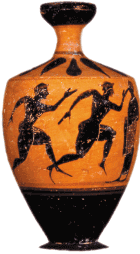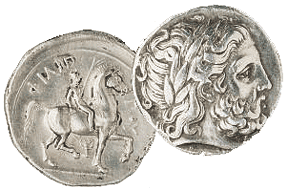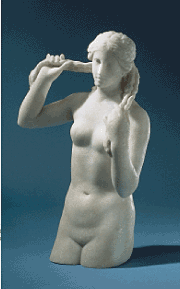![]()
Ancient
Worlds, New Space, continued
The Greek World
|
Attic black figure lekythos |
Greek
Runners
This Attic
black-figure lekythos depicts two runners racing in either the
stadion race (600 feet) or the diaulos race (1200 feet)
between two judges on the racecourse. The naked runners wear red fillets
on their heads. The vase was made in Athens in about 550 B.C. and likely
depicts an athletic event from the Panathenaic Games, a part of the
largest religious festival of the city, including both musical and
athletic contests held in honor of its patron goddess, Athena. The
Panathenaic Festival was one of the largest and most famous local
festivals in the Greek world in which athletic victors were given prize
amphoras filled with olive oil. The vase, about 0.29 meters high, was
excavated from a chamber tomb at Narce in Italy.
The two runners on this vase have been used as the model for a new U.S. postage stamp to be issued in conjunction with the 2004 Olympic Games.
|
Macedonian silver tetradrahm, obverse with head of Olympian Zeus, reverse with horse and rider. |
Philip II and the Olympic
Games
This silver
tetradrahm, struck in Macedonia, depicts a walking horse and rider on its
reverse side. The naked rider holds a palm branch symbolizing victory. The
obverse side shows a bearded silhouette of Zeus, a portrait of the
colossal gold and ivory cult image of Zeus by Pheidias that was housed in
the Temple of Zeus at Olympia. The coin was manufactured by Philip II,
King of Macedonia, to commemorate his victory in the horse race at the
Olympic games in 356 B.C. The letters above and to the right side of the
horse spell out, “of Philip,” referring to the victory.
The Roman writer Plutarch in his Life of Alexander tells us that Philip received three messages on the same day in the summer of 356. The first told of the victory of one of his generals, Parmenio, over the Illyrians; the second mentioned the victory of his race horse at Olympia; and the third told of the birth of his son Alexander. Clearly Philip was not at Olympia during this contest, nor did he come in 352 or 348 B.C., when his equestrian teams won two additional victories there. Later, in 338 B.C., Philip defeated the allied forces of the Greeks at Chaeronea to assume leadership of the Greek states.
—Dr. David Gilman Romano Gr’81, senior research scientist, Mediterranean Section
|
Marble statuette of Aphrodite. |
The Benghazi
Venus
The malodorous
salt-flats outside of the eastern Libyan city of Benghazi may have once
marked the location of legendary Lake Tritonis and its island Temple of
Aphrodite, today covered with a Moslem cemetery. This area is the place of
origin of the Museum’s exquisite statuette of a naked Aphrodite daintily
wringing the salt-water out of her hair while she rises from the sea—under
the circumstances not unlike a gorgeous butterfly emerging from an ugly
caterpillar. Carved from large-grain gray-white Parian marble, she rises
less than 13 inches above her cut-off thighs. While some have argued that
she might have been originally displayed standing thigh-deep in a pool of
water, the angles of the cuts make her appear to be toppling backward.
Perhaps she was damaged in antiquity, since laboratory analysis reveals no
signs of her having been reshaped in modern times—nor clad in separately
carved drapery below the waist for that matter. Her type ultimately
derives from a famous lost masterpiece by the painter Apelles from the
island of Cos. Goddess of physical desire and carnal sex, her raw
physicality has been muted here by the figure’s refined carving and the
slightly blurry, “veiled” expression achieved around the eyes by the
deliberate crushing of the marble’s crystalline surface (unless she was
over-cleaned with dilute acid before she came to the museum, a possibility
one would just as soon overlook!). One of the smaller examples of the
stone carver’s craft in the Museum’s collection, she is also one of our
very finest, exemplifying perfectly the Greeks’ renowned abilities to
create masterpieces in miniature.
—Donald White
![]()


